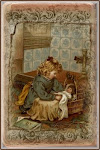 QUILTING TIPS
QUILTING TIPSUse a rotary cutter. Keep a spare blade available and change the blade when it gets nicked or dull. It makes cutting so much easier and you can cut through multiple layers (up to 6).
After you stitch your pieces together to form a block, measure the block using a clear quilter's ruler and slice off the access. This may take extra time in the beginning but it will help your quilt patches fit together so much easier and better.
 When stitching rows of squares together press the seams of one row one way and the seams of the other row the opposite directions. When you stitch them together, they will fall together more smoothly at the seams so the right side will look like you matched the seams perfectly.
When stitching rows of squares together press the seams of one row one way and the seams of the other row the opposite directions. When you stitch them together, they will fall together more smoothly at the seams so the right side will look like you matched the seams perfectly.Buy yourself a good book on rotary techniques. It's amazing how much time you can save with these little razor cutters.
 I think the importance of the scant 1/4" seam is probably the most important fact about quilting. Investing in a 1/4" foot for your particular machine will be the biggest quilting favor you could ever do for yourself. If each of your blocks are sewn together with just a bit over a 1/4", by the end of the row of blocks, you're off quite a bit. I highly recommend Alex Anderson's Beginning Quilting (I think that's the name of it) for new quilters.
I think the importance of the scant 1/4" seam is probably the most important fact about quilting. Investing in a 1/4" foot for your particular machine will be the biggest quilting favor you could ever do for yourself. If each of your blocks are sewn together with just a bit over a 1/4", by the end of the row of blocks, you're off quite a bit. I highly recommend Alex Anderson's Beginning Quilting (I think that's the name of it) for new quilters.Wind several bobbins ahead of time so you don't have to unthread your machine. A real time saver.
Not all quilts require a 1/4" seam allowance.....They just require accuracy. (I know I just really upset a lot of the purest quilters). But such patterns as the rail fence are great for beginners. I have found that if I can get them to make an accurate and consistent seam allowance first, then the 1/4" is no problem.
1/4" foot! Yeah! My favorite. To help the beginner....go to the Dr Scholl foot section and pick up some moleskin. Cut a small strip and place it in front of the foot, lining the left hand edge with the right side of the foot. It helps to control the fabric.
Prewash, iron and starch the fabric with 1:1 ratio of liquid starch and water. Stops fabric from slipping under foot, makes ripping out easier and reduces stretching.
When stitching flannel quilts or quilts with Bias seams, use the walking foot to reduce stretching.
 There are no Quilt Police! Relax and enjoy the process. If you actually finish the project so much the better. Many quilters are way too critical of their output. So stop listening to the naysayers right now. Your UFO may become someone else's future masterpiece. Make it a game. See how far you can stretch yourself when choosing fabrics, or learning a new technique. Finish someone else's UFO. Try at least one project where you tell yourself you can't go to the store for the perfect fabric but must make design choices from what you already have. You'll start to see your stash in a new way! The quilt you consider ho-hum may be snappy to someone else. Early quilters didn't have the benefit of cable television instruction, rotary cutters, neatly woven and firmly starched fabrics, full color spectrum lights and Gutermann thread. Still they produced quilts that make your heart sing a hundred years later.
There are no Quilt Police! Relax and enjoy the process. If you actually finish the project so much the better. Many quilters are way too critical of their output. So stop listening to the naysayers right now. Your UFO may become someone else's future masterpiece. Make it a game. See how far you can stretch yourself when choosing fabrics, or learning a new technique. Finish someone else's UFO. Try at least one project where you tell yourself you can't go to the store for the perfect fabric but must make design choices from what you already have. You'll start to see your stash in a new way! The quilt you consider ho-hum may be snappy to someone else. Early quilters didn't have the benefit of cable television instruction, rotary cutters, neatly woven and firmly starched fabrics, full color spectrum lights and Gutermann thread. Still they produced quilts that make your heart sing a hundred years later.Consider using grey thread when piecing. Light, medium, or dark values of grey visually disappear in the seams, especially when piecing a light and dark fabric together. It also simplifies preloading bobbins as there are fewer colors to consider.
 Also, don't use black thread. Use navy thread (or dark grey) instead. Often black thread is over dyed more than once by the manufacturer when the original color turned out wrong. The extra layers of dye and sizing can cause newer machines to "misread" the thread as it passes through the thread tensioning mechanisms. A tip from a local Bernina repairman.
Also, don't use black thread. Use navy thread (or dark grey) instead. Often black thread is over dyed more than once by the manufacturer when the original color turned out wrong. The extra layers of dye and sizing can cause newer machines to "misread" the thread as it passes through the thread tensioning mechanisms. A tip from a local Bernina repairman.The 1/4 inch quilters foot (with a right-side fence)is my best friend! I can get accurate, consistent seam allowances across even the largest quilt with absolutely no effort. Ask for one at your sewing machine shop. I wouldn't be marooned on a tropical island without my quilters foot!
Change your sewing machine needle after 8-10 hours of service. Most problems with poor output on your sewing machine are produced by a worn needle. For about $0.80 a needle you can keep problems at bay.
Visit a quilt guild or group. They usually have chocolate or treats. You'd be amazed at what you can pick up by quietly observing and listening. This is especially true if you are a visual or aural learner. (That's where I learned the great tip about Glad Press and Seal Wrap to transfer designs. Just lay the wrap on the original design, trace it onto the Wrap, then lay the wrap on your fabric and stitch right over it. It will rip away cleanly. Neat, huh?). Caution: Be on guard for naysayers at any quilt gathering. There are no absolute ways to do things. Give the "expert" advice at least one good try but if it doesn't work for you, jettison that advice and find your own way. Start viewing Mary Kay Fuschia lipstick as a neutral color, put your bindings on back to front, wash your quilt in the hottest water and dryer if you want maximum shrinkage, mix both machine and hand quilting on a single piece, hand quilt without a hoop, cut your stripes casually off grain, use fabric markers to heighten color intensity or contrast, whatever. Do what makes you happy! Your positive spirit will be captured in your work.
ALWAYS retract your rotary blade. That little blade can do a lot of damage to feet, fingers, cat's tail, etc.
Put a piece of batting next to your sewing machine to collect those pieces of cut threads.
Use a bamboo skewer to feed heavier seams through the machine.
My best tip is to stop sewing when you are tired. It is much easier to stop than it is to rip out (take it from one who knows). I use a tilt table under my machine and a good chair as I have back problems.
My best tip is to press, press, press!!! Press those seams either open or one way but then turn the piece over and press again without stretching the fabric. Everything fits so much better when pressed.










.jpg)







































































.jpg)


























.JPG)















4 comments:
Those all sound like good tips to this new soon to be quilter. I am getting my sewing machine this weekend. Yea! I have been reading the "Quilters Bible". I am going to check out the book you recommend too. I am excited to learn this traditional form of art.
Good tips and reminders. Especially the "quit when you're tired"! I think a lot of us have been there and had to rip seams at one time or another. Thanks, jo
Great post with some new to me tips. I have inherited other folks UFO`s and I`m on the way to my sewing machine!
Hi :)
Thank You for helpful tips. I find you blog very interesting and I've decided to stay for longer :) Have a nice day!
Margot
Post a Comment